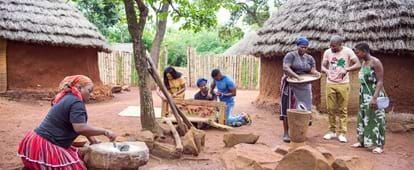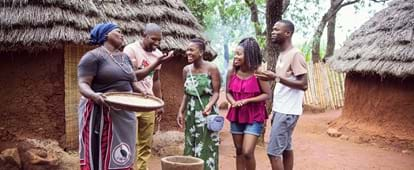By creating an account, I agree to the
Terms of service and Privacy policy
Choose your country and language:
Africa
Americas
Asia Pacific
Europe
TThe Tsonga people are a diverse group of tribes that include the Shangaan, Thonga, Tonga, Vandzawu, VaTshwa, Vakalanga and Valoyi to name a few. Tribal differences often lead to rejection of the title Shangaan or Tsonga, depending on who you’re speaking to. It’s important to understand that Tsonga people share one origin, but each tribe has assumed different identities. Tsonga people can be found in South Africa, Mozambique and Zimbabwe.
In 1999, the Shangaan Cultural Village was established in Hazyview, Mpumalanga, and is aimed at increasing tourism and educating visitors on Shangaan culture. It has also become a central part of job creation and economic development in the area.
The origins of Tsonga people date back to the days of King Shaka Zulu, when they were known for bartering fabric and beads for copper, ivory and salt. King Shaka sent Soshangane (Manukosi) to conquer present-day Southern Mozambique in the 19th century during the Mfecane upheaval. Soshangane was captivated by the beauty and fertility of the land as well as the humility of its people, which consisted of Nguni and Tsonga tribes. Soshangane captured and ruled the tribe against Shaka’s wishes, and taught his new tribe the ways of the Zulu. Young Tsonga men were trained as soldiers according to Shaka’s military system, and this army overran Portuguese communities in Mozambique. Soshangane founded and was king of the Gaza Kingdom, which was located in south-eastern Africa in the area of southern Mozambique and south-eastern Zimbabwe.

IIn 1828, Shaka sent an army led by Dingane and Mhlangana to deal with Soshangane, but they were defeated. This spurred on a chaotic period during which Tsonga people moved southwards and defeated groups in Northern Natal (now KwaZulu-Natal), while others moved to the Transvaal (now Gauteng) and settled in areas such as Soutpansberg, Nelspruit, Barberton and Rustenburg.
Soshangane died in 1856 and his sons Mzila and Mawewe fought over chieftainship despite the fact that Soshangane left the crown to Mzila. Mawewe drove Mzila and his followers out of Mozambique to Soutpansberg Mountains in the Transvaal. Mzila later defeated Mawewe with help of the Portuguese Vice-Consul to South Africa in 1862. Various battles followed, which led to the Tsonga-Shangaan homeland, Gazankulu, forming in the Northern Transvaal Province in the 1960s. It was recognised as a self-governing state in 1973, and the economy of the state was driven by gold and a small manufacturing industry. An estimated 500 000 Shangaan people lived there - the rest of the Shangaan can now be found in urban areas such as Pretoria and Johannesburg.
In a traditional setting, the economy is driven by agriculture and pastoralism, and the staple food of the Tsonga includes corn, millet, sorghum and other crops. Women do most of the agricultural work while men and boys look after livestock and grow cash crops. With the development of the South African economy, most Tsonga men depend on wage labour for cash and migrate to various urban areas to make a living.

TThe Shangaan people are also custodians of a unique genre of music known as Shangaan Electro, which originates from Tsonga Disco and Kwaito House. The music is characterised by an extremely fast-paced beat, fluid guitar lines and drumming influenced by Thomas Chauke and Paul Simon. Shangaan Electro beats can go up to 190bpm, and this genre is specifically created for dancing, particularly footwork that can be compared to isipantsula and is often referred to as Xibelani. The dancers are often decked in colourful attire.
One of the pioneers of Shangaan Electro is an artist named Sho Nozinja, who is also known for taking Shangaan Electro to Europe and the US after being discovered by another artist, Wills Glasspiegel. Nozinja is also behind large street parties that take place. Here you’ll experience the thrill of Shangaan Electro, and people from miles around can feel the fast-paced beat reverberate around them. Nozinja’s music was initially released in 2010, followed by a compilation of remixes from international acts including Theo Parrish, Actress, Hype Williams and Anthony “Shake” Shakir.
Shangaan culture has certainly evolved, and made international inroads. However, tribal divides continue to plague South Africa as does discrimination, and people remain skeptical of whether the music has an audience. However, artists like Sho Madjozi are proving that the Shangaan culture is relatable.

AAbout the author
Vuyo Seripe is a multi-talented writer who enjoys working with all things digital. She has written content for multiple clients who have commended her for being tenacious and creative. She started writing nine years ago under the mentorship of award-winning writer, Andrew Miller. She has since written for online publications and print publications on various topics about emerging urban cultures, social ills and the development of the digital landscape.
Related articles

